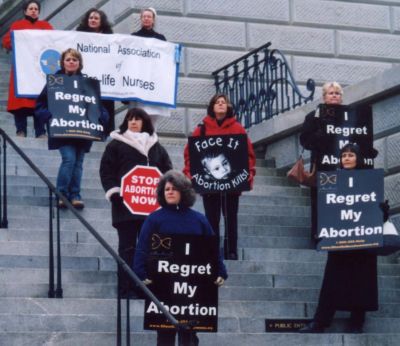 All in all, it appears to have been an exceptionally quiet year on the March for Life coverage front. I, for one, was a bit disappointed that things stayed so low-key, in part because you know that the U.S. Supreme Court hearings have cranked up the work -- on both sides -- behind the scenes.
How low-key? This is one year in which it is pretty hard to tell the Washington Times coverage from the Washington Post coverage, at least at the levels of the main stories. In the Post, things got a bit more lively in Dana Milbank's column, which -- fair enough -- sounded sirens to mainstream Washington that those frightening anti-abortion folks are currently feeling their political oats. Quick, break out those checkbooks and mail something to NARAL Pro-Choice America.
All in all, it appears to have been an exceptionally quiet year on the March for Life coverage front. I, for one, was a bit disappointed that things stayed so low-key, in part because you know that the U.S. Supreme Court hearings have cranked up the work -- on both sides -- behind the scenes.
How low-key? This is one year in which it is pretty hard to tell the Washington Times coverage from the Washington Post coverage, at least at the levels of the main stories. In the Post, things got a bit more lively in Dana Milbank's column, which -- fair enough -- sounded sirens to mainstream Washington that those frightening anti-abortion folks are currently feeling their political oats. Quick, break out those checkbooks and mail something to NARAL Pro-Choice America.
The snarky line of the day was also, perhaps, the most insightful factual observation about the strange state of abortion politics. Pay close attention to the second paragraph of reporter Michael Janofsky's story in the New York Times.
As they have every year since the Supreme Court first ruled in Roe v. Wade, abortion opponents flooded the capital on Monday with an energetic rally featuring speeches, prayers and signs that urged an end to abortions across the country.
In most respects, the rally was similar to the 32 that preceded it, as tens of thousands of people packed several blocks of the Mall before marching toward the Capitol and the Supreme Court. For the sixth straight year, President Bush was out of town for the rally, though he offered words of encouragement through an amplified telephone line.
Zing. This is precisely the kind of observation about the Republican president that you were likely to hear during the march, should you be marching alongside pro-lifers who are on the political left.
Which brings me to my main observation. This year's MSM coverage of the march was quite bland. In some ways, this is good. No one singled out tiny groups of hot-tempered radicals on the right and portrayed them as the norm. At the same time, I can't find anyone who sought out some of the quirkier (and, yes, much smaller) groups that often support marches of this kind. Like who? Would you believe Libertarians for Life? And then there is the Pro-Life Alliance of Gays and Lesbians, a group that is concerned that a DNA hook for homosexual tendencies might have terrifying results. One can also find pro-life groups in the world of oldline, usually liberal, Protestantism -- such as the National Organization of Episcopalians for Life.
The goal, of course, is to cover the mainstream and, in the pro-life movement, that means covering young people and women from evangelical, Roman Catholic and Eastern Orthodox sanctuaries, with a vocal presence of Orthodox Jews, as well. Perhaps the most important group at the moment is called "Silent No More," in large part because the women with the somber, black "I Regret My Abortion" signs (photo from an earlier event, new photos here) are the archetypal opposites of the people who used to dominate television-news reports about these events. You know, that would be the angry men with red faces, bullhorns and bloody posters.
The women at these marches represent the mainstream. However, I was surprised -- and disappointed, I admit -- that this year's mini-wave of coverage did not include more commentary from the left (the pro-life left and the pro-abortion-rights left). Yes, I wanted to hear more from the protesters and from the small, symbolic, groups in the march. I guess that, once again, my bias in favor of balance is showing.
